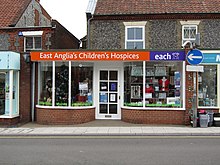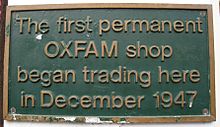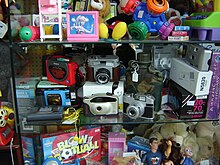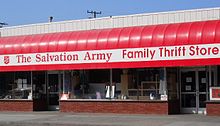Are Thrift Stores Encouraging Fast Fashion

A charity store in Sheringham, UK
A charity shop (British English language), austerity shop or thrift shop (American English and Canadian English) or opportunity store (Australian English and New Zealand English) is a retail institution run by a charitable organization to raise money. Clemency shops are a type of social enterprise. They sell mainly used goods such as clothing, books, music albums, shoes, DVDs, toys, and furniture donated by members of the public, and are often staffed by volunteers. Because the items for sale were obtained for gratuitous, and business organization costs are low, the items can be sold at competitive prices. Later on costs are paid, all remaining income from the sales is used in accordance with the system's stated charitable purpose. Costs include purchase and/or depreciation of fixtures (article of clothing racks, bookshelves, counters, etc.), operating costs (maintenance, municipal service fees, electricity, estrus, telephone, limited advertizement) and the building lease or mortgage.
Some charity shops also offer for sale a limited amount of edibles such as soda drinks, water, ice cream, snacks, and candy. When available, these items are usually virtually the stores' cashiers.
Terminology [edit]
Charity shops may besides be referred to as thrift stores (in the U.s. and Canada), hospice shops, resale shops (a term that in the U.s. also covers consignment shops), opportunity (or op) shops (in Australia and New Zealand), and 2d-hands (секонд-хенды) in Russia.
History [edit]

I of the earliest known charity shops in the United Kingdom was set up by the Wolverhampton Society for the Blind (now called the Beacon Middle for the Blind) in 1899 to sell goods made past blind people to raise money for the Society.[i] During World War I, various fund-raising activities occurred, such as a clemency bazaar in Shepherd Market, London, which made £50,000 for the Carmine Cross.[2]
Nonetheless, it was during the 2d Globe War that the charity shop became widespread. Edinburgh University Settlement opened their "Thrift Shop for Everyone" in Edinburgh in 1937,[3] the Red Cross opened upward its first charity shop at 17 Old Bond Street, London in 1941. For the duration of the war, over two hundred "permanent" Red Cross gift shops and most 150 temporary Red Cross shops were opened. A condition of the store licence issued past the Board of Merchandise was that all appurtenances offered for sale were gifts. Purchase for re-sale was forbidden. The entire proceeds from sales had to be passed to the Duke of Gloucester'southward Blood-red Cross or the St John Fund. Most bounds were lent free of rent and in some cases owners also met the costs of heating and lighting.[ citation needed ]
The first Oxfam clemency shop in the United Kingdom was established by Cecil Jackson-Cole in Broad Street, Oxford, and began trading in December 1947.[four]
Popularity [edit]

In the early on 2010s, shopping at a charity shop became pop enough to earn a name in the United States: thrifting. Environmentalists may prefer ownership second-hand goods every bit this uses fewer natural resources and would unremarkably practice less damage to the environment than by buying new goods would, in part because the goods are commonly collected locally. In addition, reusing 2nd-hand items is a form of recycling, and thus reduces the amount of waste material going to landfill sites. People who oppose sweatshops frequently purchase second-hand wearable equally an alternative to supporting article of clothing companies with dubious ethical practices. People who desire authentic vintage clothing typically shop at charity shops since most clothing that is donated is quondam and out of normal fashion, or is from a recently deceased person who had not updated his clothing for a long time. Many YouTube channels brand thrifting videos showcasing fashionable and unusual finds.
2d-paw goods are considered to be quite safe. The South Australian Public Health Directorate says that the wellness risk of ownership used clothing is very low. It explains that washing purchased items in hot water is simply one of several means to eliminate the adventure of contracting infectious diseases.[v]
Another reason for charity store popularity is the hazard to occasionally find rare or collectible items at these stores.
Sale of new goods [edit]
Some charity shops, such as PDSA , also sell a range of new goods which may be branded to the clemency, or accept some connection with the crusade the charity supports. Oxfam stores, for instance, sell fair trade nutrient and crafts. Charity shops may receive overstock or obsolete goods from local for-profit businesses; the for-profit businesses do good by taking a tax write-off and clearing unwanted goods from their shop instead of throwing the goods out, which is plush.
Charity shops by region [edit]
Australia [edit]
In Australia, major national opportunity shop bondage include the St. Vincent de Paul Thrift Store (trading as Vinnies) which operate 627 shops across Australia,[6] Anglicare Shops, that currently operate in nineteen locations across Sydney and the Illawarra besides various locations around Australia, the Salvation Army (trading as Salvos), the Red Cantankerous, MS Research Commonwealth of australia, and the Brotherhood of St. Laurence. Many local charitable organisations, both religious and secular, run opportunity shops. Common among these are missions and animal shelters.
Denmark [edit]
Almost of the clemency shops in Denmark are operated by either The Danish Red Cross or by christian organizations. The Danish Red Cross has 250 shops in the land and 10,000 volunteers working in the shops.[seven] DanChurchAid has since 1972 operated charity shops, and currently operates 114 shops.[8] The Bluish Cross, founded every bit a christian organisation,[ix] besides runs 55 clemency shops in the country, and focuses mainly on helping alcoholics, addicts and other socially marginalized groups.[10]
A written report from 2019 shows that danes on boilerplate had spend 5.475 kr. on second-manus items the concluding 12 months, and that 77% of danes had either shopped or sold second-hand, although the study was not sectional to charity shops.[11]
| Crimson Cross | Bluish Cantankerous | Folkekirkens nødhjælp (DanChurchAid) | Kirkens Korshær (The Church building's Regular army) | Kræftens Bekæmpelse (The Fight of Cancer) |
|---|---|---|---|---|
| c. 250[7] | 55[10] | 114[8] | 240[12] | fifteen[13] |
Great britain [edit]

Window display in a UK charity shop.
Oxfam has the largest number of charity shops in the United kingdom of great britain and northern ireland with over 700 shops. Many Oxfam shops also sell books, and the arrangement now operates over 70 specialist Oxfam Bookshops, making them the largest retailer of second-hand books in the Great britain. Other Oxfam affiliates also have shops, such equally Jersey, Federal republic of germany, Ireland (45 shops in NI/ROI), the netherlands and Hong Kong. Other charities with a potent presence on high streets in the United kingdom include The Children's Social club, YMCA, British Heart Foundation, Barnardos, Cancer Research Great britain, Shelter, Roy Castle Lung Cancer Foundation, Age UK (formerly Age Concern and Help the Aged), Marie Curie Cancer Intendance, Norwood, Salvage the Children, Scope, PDSA, Naomi Firm Children's Hospice and Sue Ryder Care. Many local hospices also operate charity shops to enhance funds.
At that place are over 9,000 charity shops in the UK and Republic of Ireland. Their locations tin can exist establish on the Charity Retail Clan (CRA) website,[14] along with information on clemency retail, what shops can and can't accept, etc. The CRA is a member organization for charities which run shops. British clemency shops are mainly staffed by unpaid volunteers, with a paid shop manager. Appurtenances for sale are predominantly from donations - 87% according to the official estimate.[15] Donations should exist taken directly to a charity shop during opening hours, as goods left on the street may be stolen or damaged by passers-by or inclement weather condition. In expensive areas, donations include a proportion of good quality designer habiliment and charity shops in these areas are sought out for cut-price fashions.[ citation needed ] 'Standard' charity shops sell a mix of clothing, books, toys, videos, DVDs, music (like CDs, cassette tapes and vinyl) and bric-a-brac (similar cutlery and ornaments). Some shops specialise in certain areas, like vintage clothing, furniture, electrical items, or records.
The two largest charity shops in the UK are run by Emmaus. Emmaus Preston shop opened in 2016 is on ane level and covers 47,000 square feet and Emmaus in Rochdale operate a three floor Section Store since January 2019 which offers the department store experience to the charity store. These stores are run by Emmaus Companions and the money they generate direct benefit the people who work in it. Both stores sell predominantly article of furniture and white appurtenances only include smaller concessions of clothes, bric-a-brac, books and music.
Almost all charity shops sell on their unsold textiles (i.east. unfashionable, stained or damaged fabric) to textile processors. Each charity shop saves an average of 40 tonnes of textiles every twelvemonth, by selling them in the shop, or passing them on to these material merchants for recycling or reuse. This grosses to effectually 363,000 tonnes across all charity shops in the United kingdom of great britain and northern ireland; based on 2010 landfill taxation value at £48 per tonne, the value of textiles reused or passed for recycling by charity shops in terms of savings in landfill tax is £17,424,000 p.a.[16] Souvenir Assist is a U.k. tax incentive for private donors where, subject field to a signed annunciation beingness held by the charity, income tax paid on donations can be reclaimed by the clemency. Although initially intended only for cash donations, the scheme now (since 2006) allows tax on the income earned by charity shops interim as agent for the donor to be reclaimed.[17]
Clemency shops in the UK become mandatory lxxx% relief on business rates on their premises, which is funded past central government (not by local ratepayers) and is one analogy of their support for the charity sector and the office of charity shops in raising funds for charities.[18] Charities can use for discretionary relief on the remaining xx%, which is an occasional source of criticism from retailers which have to pay in total.[19]
Largest charity retailers [edit]
The Charity Shops Survey 2017 revealed the x largest charity retailers in the United kingdom based on almanac income and number of stores.[20]
| Charity | Annual Income (£) | Number of Stores |
|---|---|---|
| British Heart Foundation | £176.4m | 724 |
| Oxfam GB | £92.5m | 640 |
| Cancer Research United kingdom | £84.5m | 594 |
| Barnardo's | £70.3m | 710 |
| Sue Ryder | £55.0m | 451 |
| The Conservancy Army | £48.0m | 230 |
| Historic period UK | £42.6m | 404 |
| British Reddish Cantankerous | £30.0m | 341 |
| Scope | £21.3m | 225 |
| Marie Curie | £16.4m | 178 |
United states of america [edit]

Conservancy Army Thrift Store, Santa Monica, California USA
In the United States, major national austerity shop operators include Goodwill Industries, Conservancy Army, St. Vincent de Paul Thrift Store, and ReStore[21] (operated by Habitat for Humanity). Value Village/Savers, while looking similar a austerity store and selling donated goods, is actually a private, for-turn a profit company. Regional operators include Deseret Industries in the Western United States, and those run by Bethesda Lutheran Communities in the Upper Midwest. Many local charitable organizations, both religious and secular, operate thrift stores. Common among these are missions, children's homes, homeless shelters, and animal shelters. In addition, some austerity stores are operated past churches every bit fundraising venues that support activities and missionary work.
See as well [edit]
- Consignment
- Car kick sale
- Flea market place
- Give-away shop
- Jumble sale
- Surplus shop
- Sustainable clothing
References [edit]
- ^ "Thrift Store or Treasure Trove–You Determine". Archived from the original on 21 August 2017. Retrieved 23 Oct 2013.
- ^ Fundraising During The Offset Earth War (PDF). British Cherry Cross. p. 3. Retrieved 31 March 2020.
- ^ McCrone, David (2017). The New Sociology of Scotland. SAGE. ISBN9781473987814 . Retrieved 31 March 2020.
- ^ Ruddick, Graham (fourteen August 2015). "Oxfam faces tough new test in the era of Lidl, Aldi and Primark". The Guardian . Retrieved 31 March 2020.
- ^ "Second-hand goods: A guide for consumers" (PDF). Public and Environmental Health Service website. Department of Health, Government of South Australia. October 2008. Archived from the original (PDF) on 1 January 2011. Retrieved 16 July 2010.
As the risk to health associated with second-hand goods is very low, thorough and hygienic cleaning is all that is required to eliminate the run a risk of contracting infectious diseases. ... Washing second-manus clothing and bedding in hot water (hotter than 60°C) and detergent kills these disease-causing organisms. Items that cannot be washed ...
- ^ "How many Vinnies shops are there?". Retrieved 2 October 2016.
- ^ a b "Genbrugsbutikker". Røde Kors (in Danish). Retrieved 21 Feb 2022.
- ^ a b "Bliv frivillig på Nørrebro i Gemmeren, en genbrugsbutik for ugne". noedhjaelp.dk - Folkekirkens Nødhjælp (in Danish). Retrieved 21 Feb 2022.
- ^ "Værdier og grundlag i Blå Kors Danmark | Blå Kors". Værdier og grundlag i Blå Kors Danmark | Blå Kors (in Danish). Retrieved 21 February 2022.
- ^ a b "Blå Kors Genbrug | Blå Kors". Blå Kors Genbrug | Blå Kors (in Danish). Retrieved 21 February 2022.
- ^ "DBA Genbrugsindeks 2019: Danskerne genbruger som aldrig før". guide.dba.dk . Retrieved 21 Feb 2022.
- ^ "Om Kirkens Korshær | Kirkens Korshær". kirkenskorshaer.dk (in Danish). Retrieved 21 February 2022.
- ^ "Kræftens Bekæmpelse Genbrug". Kræftens Bekæmpelse (in Danish). Retrieved 21 February 2022.
- ^ Charity Retail Association FAQ Archived 6 December 2010 at the Wayback Auto
- ^ Clemency Retail Association FAQ Archived 6 December 2010 at the Wayback Motorcar
- ^ Charity Retail Association Reuse FAQ Archived 6 December 2010 at the Wayback Automobile
- ^ HMRC Gift Aid Archived 6 June 2007 at the Wayback Machine
- ^ Charity Retail Association FAQ Archived half-dozen Dec 2010 at the Wayback Machine
- ^ "BBC NEWS — Uk — England - Cornwall - Call to cut charity shops in town". news.bbc.co.united kingdom . Retrieved 9 May 2017.
- ^ "United kingdom of great britain and northern ireland's largest charity shop retailers revealed in survey". www.civilsociety.co.uk . Retrieved 22 June 2020.
- ^ "Habitat for Humanity ReStores". Habitat for Humanity . Retrieved 9 May 2017.
External links [edit]
- Clemency Retail Association (United kingdom)
0 Response to "Are Thrift Stores Encouraging Fast Fashion"
Post a Comment